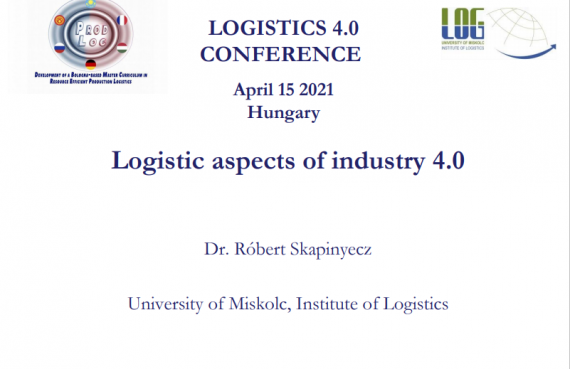
On April 15, 2021, the Department of Logistics, KSTU named after I. Razzakova, as part of teachers and undergraduates, at the invitation of the conference organizer, the University of Miskolc (Hungary), took part in a scientific conference called "Logistics 4.0".
The conference began at 9:00 am Budapest time and was opened by Dr. Peter Tamas, Director of the Institute, Associate Professor at the University of Miskolc. He welcomed the participants to the conference and emphasized the importance of such meetings for sharing knowledge despite the pandemic.
At the conference "Logistics 4.0" researchers presented their reports on the following topics: "Logistic aspects of Industry 4.0" - Dr. Robert Skapinec, Associate Professor (University of Miskolc), "Heuristic Approach to Logistics Problems" - Dr. Peter Veres, Associate Professor (University of Miskolc), " Impact of the pandemic on global logistics processes "- Gabor Nagy, Researcher (University of Miskolc)," Improving the efficiency of production and logistics processes in the Industry 4.0 environment "- Ibola Hardai, PhD student (University of Miskolc)," Impact of the procurement portfolio according to the principle of "exactly in turn "To improve the efficiency of production processes" - Janos Juhas, postgraduate student (University of Miskolc), "Traffic modeling from the point of view of transport logistics" - Laszlo Erdey, postgraduate student (University of Miskolc).
Logistics 4.0 is one of the most advanced logistics methods, using networks, digital technologies and cloud computing. In Logistics 4.0, the logistician has broader functions and tasks, if previously the logistician was limited to simple transportation, then in the conditions of modern reality and technology, the logistician focuses on the functional and organizational coordination of logistics throughout the supply chain. The term Logistics 4.0 itself was coined in relation to the term Industry 4.0, a term first used in Hannover at the IAA Commercial Vehicles in 2011, and means that we are currently experiencing the peak of the fourth industrial revolution. The first industrial revolution came with the use of steam, the second with the advent of electricity and the introduction of assembly lines. The third industrial revolution - also known as the digital revolution - began with manufacturing automation and the use of electronics such as programmable logic controls.
Logistics 4.0 develops this trend by combining modern information and communication technologies. The result is that intelligent and digital networked systems are designed so that people, machines, factories, logistics and products can communicate with each other directly, which creates a synergistic effect. If, due to use the latest technologies, logistics are integrated into the supply chain at the earliest stages, then it is possible to obtain the effect of optimizing production "just in time", as well as transport companies can hope for increased safety in planning, more efficient use of the fleet and reduced waiting times in the zone loading.
The conference participants highly appreciated the works presented at the conference, the rich history of the university and a good basis for conducting research favorably distinguish the University of Miskolc. Department of "Logistics" KSTU named after I. Razzakova and the University of Miskolc cooperate on the ProdLog program (resource efficient production).
Until 1990, the University of Miskolc was called the Technical University of Heavy Industry and is currently the largest university in Northern Hungary.
The university was founded by Act of Parliament in 1949. The university is the successor to the University of Mining and Metallurgy at Selmecbánya (established in 1735), which was one of the first schools under non-ecclesiastical rule in the Habsburg Empire. After the collapse of Austria-Hungary, the name of the university was changed to the Hungarian Royal Academy of Mining and Forestry.
Currently, the University of Miskolc has over 100 faculties, about 850 teachers and over 15,000 students.